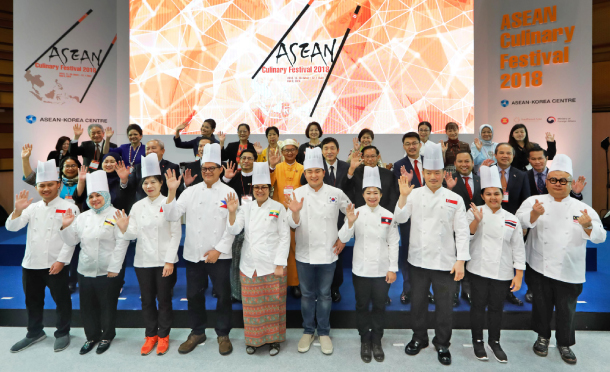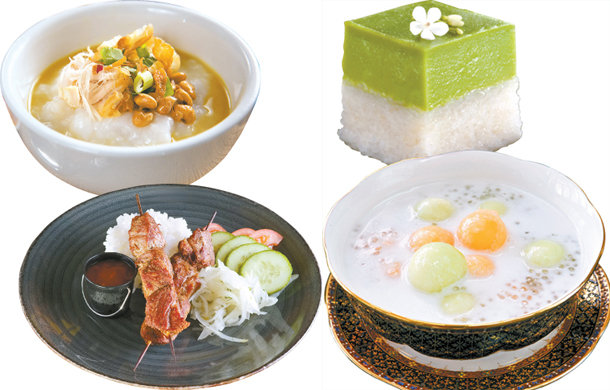Tasting Asean’s finest rice dishes in Seoul: Festival celebrates the diverse tastes, cultures of Southeast Asia

Visitors to the Asean Culinary Festival enjoy a variety of rice dishes served on Thursday at Coex, southern Seoul. Some traditional performances were presented as well, including the one by the Indonesian team pictured on the left. [PARK SANG-MOON]
Each of the 10 Asean member countries - which include Brunei Darussalam, Thailand, Vietnam, Singapore, Indonesia, Malaysia, Myanmar, Cambodia, Lao PDR and the Philippines - will present rice dishes at the festival, so visitors can learn how each country uses the same ingredient differently. Some prepare steamed rice with spiced meat or vegetables, while others make noodles with rice to serve in a soup or a porridge. Each country’s booth is set up so visitors can get a taste of their dish and hopefully be inspired to plan a trip to see what other foods they have to offer. Desserts will also be available.
“Invest time in Asean food and get [inspired to plan] a trip to the Asean region,” said Secretary General Lee Hyuk of the Asean-Korea Centre - an intergovernmental organization mandated to promote economic and socio-cultural cooperation among the Asean member nations and Korea since 2009 - during his opening remarks for the festival on Thursday.

Visitors to the Asean Culinary Festival enjoy a variety of rice dishes served on Thursday at Coex, southern Seoul. Some traditional performances were presented as well, including the one by the Indonesian team pictured on the left. [PARK SANG-MOON]
“More people are traveling than ever before, and food is a reflection of locals’ [daily life],” said the Myanmar minister, adding that travelers would like to discover the local food of the country in addition to visiting some of the well-known touristic spots. He added that travel bolsters not only the local hospitality industry, but also the economy.
To add a local twist to the event, the festival invited a celebrity chef from Korea to work with each Asean chef. Chef Lee Won-il of Be. Meal Bakery and Kimbap Lab took the stage with Dato HJ Chef Ismail Ahmad of Malaysia to demonstrate how Korean food culture mixes well with dishes from the Asean region. In the demonstration, he used kimchi to make a curry dish, one of the most popular dishes in Southeast Asia.
“To me, Asean food is something electrifying,” chef Lee told the Korea JoongAng Daily. “Asean countries are located in an area where you can feel the warm sunlight and that sunlight gives you a sense of intensity.”

Top: Bubur Ayam, chicken porridge from Indonesia. Above: Sack Kor Ang Jangkak, rice with grilled beef skewers from Cambodia. Top right: Kuih Seri Muka, layered glutinous rice cake from Malaysia. Bottom right: Bua Loy Nam Kati, tapioca in coconut cream from Thailand. [ASEAN-KOREA CENTRE]
Brunei Darussalam is serving Nasi Katok - rice with different types of meat, vegetables and spicy sauces - while Cambodia is serving Sack Kor Ang Jangkak - rice with beef skewers. Malaysia, the Philippines and Thailand are also serving steamed rice dishes while Indonesia is introducing a porridge with chicken.
Lao PDR, Myanmar, Singapore and Vietnam are all offering different rice noodle dishes. Lao PDR, Singapore and Vietnam are also each serving up their versions of noodle soup. Myanmar’s dish for the event is Na Gyi Thoke, a rice noodle salad that is often served with curry.
To clean the palate, each booth is offering a sweet dessert. Many of the countries use rice in their desserts, such as Lao PDR’s Kaho Sang Kha Gna - which is black and white sticky rice seasoned with coconut milk and sugar - as well as Malaysia’s Kuih Seri Muka - layered glutinous rice cake, also sweetened with coconut milk. Myanmar also serves Shwe Kyi, a rice pudding topped with white poppy seeds.
There is a separate drink section where visitors can taste different coffee drinks as well as fruit juices popular in the Asean region, including mango juice.
The culinary festival doesn’t stop at serving food during the annual event at Coex. There will also be traditional performances from many of the countries as well as promotional videos to inspire visitors to make a trip to enjoy the warm weather during the cold Korean winter.
The festival is part of a larger event called Coex Food Week. The 13th edition of one of the nation’s largest food events hosts 900 different companies running about 1,500 booths. It offers consumers a chance to see what’s available in the food industry, while also providing academic seminars and conferences for industry experts looking to find new ideas to launch products.
The keyword for the 2018 Coex Food Week is “Heat:” it is an acronym of four areas the local food industry needs to review to find growth: H for HMR, known as home meal replacement in Korea; E for Eco-friendly; A for Asean food; T for Tech. During Food Week, there will also be the Korea FoodTech Conference - with CJ CheilJedang, Woowa Brothers and many others - where experts will talk about what kinds of technology can be applied to the food industry, ranging from food production to logistics and sales.
With the increase of single-person households and smaller-sized families, the market for ready-made food is steadily growing because many don’t regularly cook at home; they would rather look for an option that doesn’t require them to spend too much time cooking or sorting out food waste. Also, food from countries that Koreans often visit on holiday - such as Thailand or Vietnam - has become increasingly popular in Korea, which has led to a rise in restaurants serving their dishes across the country in recent years. Industry experts expect to see that trend continue.
BY LEE SUN-MIN [summerlee@joongang.co.kr]
The Asean Culinary Festival 2018 runs until Saturday at Coex Hall D, 3rd Floor. It opens at 11 a.m. today and Saturday, and closes at 5:30 p.m. today and 4:30 p.m. on Saturday. For more information, go to www.aseakorea.org or call (02) 2287-1115.










with the Korea JoongAng Daily
To write comments, please log in to one of the accounts.
Standards Board Policy (0/250자)